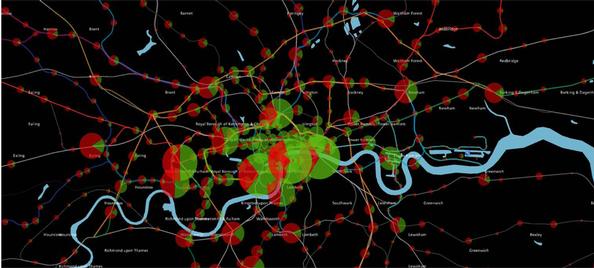

The explosion in the availability of digital and online data is opening up many opportunities for cities, city planners, and transport professionals, and Modelling World will present many opportunities to explore the options. Open data may change the future in ways that seem as inconceivable today as the rise of texting, Google and Twitter did only five years ago. Most cities are beginning to look at how they should make data available; and at how they capture, curate, and use data to identify and meet the needs of individuals. Nick Bromley, Portfolio Programme Manager at Transport for London, will be discussing his approach at Modelling World. ‘I’ve been leading on two proof of concepts that use mobile telephone radio networks to count and track crowd and vehicle movements,’ says Bromley. ‘The data can be used as input to conventional tools such as Railplan, Saturn, Transyt, LINSIG or, as we’re considering, as data input for a new tool for plotting where best to place interchange hubs. This is highly innovative, and coupled to a GIS tool, we can start to see where cycle ways should be built based on average journey lengths, where to place docking stations, or electric charging points for electric cycles, plus several other applications for transport, town planning and economic development.
‘We face a potential leap in the extent and depth of the analytic capabilities that will be available, and equally key changes in the costs of providing them’ adds John Swanson, associate, Steer Davies Gleave. The data explosion, largely but by no means exclusively driven by the Open Government Data movement, has been accompanied by data capture from devices such as GPS-enabled mobile phones and smart cards. These changes are happening now, and success will go to those with the imagination and foresight to seize the opportunities, he says.
In recent years, the quantity of data relevant to transport and city planners has increased enormously. This opens up many possibilities for new kinds of analysis based on significantly richer and timelier data than has been available in the past. One key data source that we'll be looking into at Modelling World is crowdsourcing: the act of outsourcing tasks, traditionally performed by an employee or contractor, to an undefined, large group of people or community through an open call. The term has become synonymous with the web, with volunteers providing data, monitoring quality, editing and updating, and even developing or testing software.
This raises the interesting question as to whether the existing range of tools and techniques we have measure up to the new possibilities. How will these new data sources enable us to better understand and represent travel behaviour? In the past, modelling technology often outstripped the availability of data, but suddenly we may have a reversal of this position, with the availability of data running ahead of our ability to make use of it. Given imagination and technical ability – and the evidence is that neither is in short supply – this could generate a real step change in the quality and capacity of the tools available to city and transport planners in the very near future.
This topic will be discussed in detail at the Open Data, Cities and Transport Event in Manchester this June.
Open Data forms the foundations of the programme for Modelling World this July in London
TransportXtra is part of Landor LINKS
© 2026 TransportXtra | Landor LINKS Ltd | All Rights Reserved
Subscriptions, Magazines & Online Access Enquires
[Frequently Asked Questions]
Email: subs.ltt@landor.co.uk | Tel: +44 (0) 20 7091 7959
Shop & Accounts Enquires
Email: accounts@landor.co.uk | Tel: +44 (0) 20 7091 7855
Advertising Sales & Recruitment Enquires
Email: daniel@landor.co.uk | Tel: +44 (0) 20 7091 7861
Events & Conference Enquires
Email: conferences@landor.co.uk | Tel: +44 (0) 20 7091 7865
Press Releases & Editorial Enquires
Email: info@transportxtra.com | Tel: +44 (0) 20 7091 7875
Privacy Policy | Terms and Conditions | Advertise
Web design london by Brainiac Media 2020